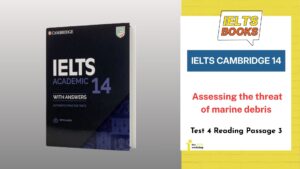IELTS Cambridge 15 được đánh giá cao bởi độ khó và sát với đề thi thật. Việc luyện tập thường xuyên cùng tài liệu uy tín giúp bạn nâng cao band điểm nhanh chóng để đạt được mục tiêu của mình. Bài viết này cung cấp đáp án, bản dịch và phân tích chi tiết IELTS Cambridge 15 Test 1 Listening Part 4: Eucalyptus Tree in Australia bởi The IELTS Workshop.
Đáp án IELTS Cambridge 15 Test 1 Listening Part 4
| Câu hỏi | Đáp án |
|---|---|
| 31 | shelter |
| 32 | oil |
| 33 | roads |
| 34 | insects |
| 35 | grass(es) |
| 36 | water |
| 37 | soil |
| 38 | dry |
| 39 | simple |
| 40 | nest(s) |
Transcript và bản dịch chi tiết IELTS Cambridge 15 Test 1 Listening Part 4
| Transcipt | Bản dịch |
| Today I’m going to talk about the eucalyptus tree. This is a very common tree here in Australia, where it’s also sometimes called the gum tree. First I’m going to talk about why it’s important, then I’m going to describe some problems it faces at present.Right, well the eucalyptus tree is an important tree for lots of reasons. For example, it gives shelter to creatures like birds and bats, and these and other species also depend on it for food, particularly the nectar from its flowers. So it supports biodiversity. It’s useful to us humans too, because we can kill germs with a disinfectant made from oil extracted from eucalyptus leaves. | Hôm nay tôi sẽ nói về cây bạch đàn. Đây là một loại cây rất phổ biến ở Úc, nơi mà nó đôi khi còn được gọi là gum tree. Trước tiên tôi sẽ nói về lý do vì sao nó quan trọng, sau đó tôi sẽ mô tả một vài vấn đề mà nó đang gặp phải hiện nay.Cây bạch đàn là một loại cây quan trọng vì nhiều lý do. Ví dụ, nó cung cấp chỗ trú ẩn cho các sinh vật như chim và dơi, và những loài này cùng với các loài khác còn phụ thuộc vào nó để lấy thức ăn, đặc biệt là mật hoa của nó. Vì vậy, cây bạch đàn hỗ trợ sự đa dạng sinh học. Nó cũng có ích cho con người, vì ta có thể dùng dầu chiết xuất từ lá bạch đàn để làm chất khử trùng tiêu diệt vi trùng. |
| The eucalyptus grows all over Australia and the trees can live for up to four hundred years. So it’s alarming that all across the country, numbers of eucalyptus trees are falling because the trees are dying off prematurely. So what are the reasons for this?One possible reason is disease. As far back as the 1970s the trees started getting a disease called Mundulla Yellows. The trees’ leaves would gradually turn yellow, then the tree would die. It wasn’t until 2004 that they found the cause of the problem was lime, or calcium hydroxide to give it its proper chemical name, which was being used in the construction of roads. The lime was being washed away into the ground and affecting the roots of the eucalyptus trees nearby. What is was doing was preventing the trees from sucking up the iron they needed for healthy growth. When this was injected back into the affected trees, they immediately recovered. | Cây bạch đàn mọc khắp nước Úc và có thể sống đến 400 năm. Do đó, việc số lượng bạch đàn trên khắp cả nước đang giảm vì cây chết sớm là điều đáng lo ngại. Vậy nguyên nhân là gì?Một khả năng là bệnh tật. Từ những năm 1970, cây bắt đầu mắc một loại bệnh gọi là Mundulla Yellows. Lá cây dần chuyển sang màu vàng rồi cây chết. Mãi đến năm 2004, người ta mới phát hiện nguyên nhân là vôi, hay tên hóa học là canxi hydroxit, được dùng trong xây dựng đường sá. Vôi bị rửa trôi xuống đất và ảnh hưởng đến rễ cây bạch đàn gần đó, khiến cây không thể hấp thụ sắt – một chất cần thiết để cây phát triển khỏe mạnh. Khi tiêm sắt trở lại cho cây bị ảnh hưởng, chúng lập tức phục hồi. |
| But this problem only affected a relatively small number of trees. By 2000, huge numbers of eucalyptus were dying along Australia’s East Coast, of a disease known as Bell-miner Associated Die-back. The bell-miner is a bird, and the disease seems to be common where there are high populations of bell-miners. Again it’s the leaves of the trees that are affected. What happens is that insects settle on the leaves and eat their way round them, destroying them as they go, and at the same time they secrete a solution which has sugar in it. The bell-miner birds really like this solution, and in order to get as much as possible, they keep away other creatures that might try to get it. So these birds and insects flourish at the expense of other species, and eventually so much damage is done to the leaves that the tree dies. | Tuy nhiên, vấn đề này chỉ ảnh hưởng đến một số ít cây. Đến năm 2000, rất nhiều cây bạch đàn bắt đầu chết dọc theo bờ Đông nước Úc, vì một căn bệnh gọi là Bell-miner Associated Die-back. Bell-miner là tên một loài chim, và căn bệnh này thường xuất hiện ở những nơi có mật độ cao của loài chim này. Một lần nữa, lá cây bị ảnh hưởng. Những gì xảy ra là côn trùng đậu trên lá rồi ăn vòng quanh, phá hủy lá khi đi qua. Đồng thời, chúng tiết ra một dung dịch chứa đường. Chim bell-miner rất thích dung dịch này, và để có được nhiều nhất có thể, chúng đuổi các sinh vật khác đi. Do đó, cả chim lẫn côn trùng phát triển mạnh, gây hại cho các loài khác, và cuối cùng làm hỏng lá cây đến mức cây chết. |
| But experts say that trees can start looking sick before any sign of Bell-miner Associated Die-back. So it looks as if the problem might have another explanation. One possibility is that it’s to do with the huge bushfires that we have in Australia. A theory proposed over 40 years ago by ecologist William Jackson is that the frequency of bushfires in a particular region affects the type of vegetation that grows there. If there are very frequent bushfires in a region, this encourages grass to grow afterwards, while if the bushfires are rather less frequent, this results in the growth of eucalyptus forests. | Tuy nhiên, các chuyên gia cho biết cây có thể trông đã ốm yếu trước khi có bất kỳ dấu hiệu nào của Bell-miner Associated Die-back. Do đó, có vẻ như nguyên nhân có thể là điều gì khác. Một khả năng là do các vụ cháy rừng lớn ở Úc. Một lý thuyết được nhà sinh thái học William Jackson đưa ra hơn 40 năm trước nói rằng tần suất cháy rừng ở một khu vực ảnh hưởng đến loại thực vật mọc ở đó. Nếu cháy rừng xảy ra thường xuyên, điều đó thúc đẩy cỏ phát triển. Trong khi nếu cháy ít hơn, nó sẽ dẫn đến rừng bạch đàn phát triển. |
| So why is this? Why do fairly frequent bushfires actually support the growth of eucalyptus? Well, one reason is that the fire stops the growth of other species which would consume water needed by eucalyptus trees. And there’s another reason. If these other quick-growing species of bushes and plants are allowed to proliferate, they harm the eucalyptus in another way, by affecting the composition of the soil, and removing nutrients from it. So some bushfires are actually essential for the eucalyptus to survive as long as they are not too frequent. In fact there’s evidence that Australia’s indigenous people practised regular burning of bush land for thousands of years before the arrival of the Europeans. | Vậy tại sao cháy rừng vừa phải lại hỗ trợ sự phát triển của bạch đàn? Một lý do là lửa ngăn các loài khác phát triển, vốn sẽ hút nước mà cây bạch đàn cần. Một lý do khác là các loài thực vật phát triển nhanh này nếu được phép lan rộng, sẽ làm thay đổi thành phần đất và làm mất đi các chất dinh dưỡng trong đất, gây hại cho bạch đàn. Do đó, một số vụ cháy rừng thực sự cần thiết để cây bạch đàn sống sót – miễn là chúng không xảy ra quá thường xuyên. Trên thực tế, có bằng chứng cho thấy người bản địa Úc đã thực hành đốt cháy rừng có kiểm soát trong hàng ngàn năm trước khi người châu Âu đến. |
| But since Europeans arrived on the continent, the number of bushfires has been strictly controlled. Now scientists believe that this reduced frequency of bushfires to low levels had led to what’s known as ‘dry rainforest’, which seems an odd name as usually we associate tropical rainforest with wet conditions. And what’s special about this type of rainforest? Well, unlike tropical rainforest which is a rich ecosystem, this type of ecosystem is usually a simple one. It has very thick, dense vegetation, but not much variety of species. The vegetation provides lots of shade, so one species that does find it ideal is the bell-miner bird, which builds its nests in the undergrowth there. But again that’s not helpful for the eucalyptus tree. | Tuy nhiên, kể từ khi người châu Âu đến, số lượng cháy rừng đã bị kiểm soát chặt chẽ. Hiện nay, các nhà khoa học tin rằng tần suất cháy thấp đã dẫn đến sự hình thành của “rừng mưa khô” – nghe có vẻ lạ vì ta thường nghĩ rừng mưa là nơi ẩm ướt. Vậy điều gì đặc biệt ở hệ sinh thái này? Không giống như rừng mưa nhiệt đới – vốn rất đa dạng, hệ sinh thái này lại rất đơn giản. Nó có thảm thực vật dày đặc nhưng ít loài. Vì rừng rậm che bóng nhiều, nên loài chim bell-miner lại thấy đây là nơi lý tưởng để làm tổ trong bụi rậm. Tuy nhiên, điều đó không tốt cho cây bạch đàn. |
Phân tích chi tiết IELTS Cambridge 15 Test 1- Listening Part 4
Question 31
Đáp án: shelter
Transcript: For example, it gives shelter to creatures like birds and bats, and these and other species also depend on it for food, particularly the nectar from its flowers. So it supports biodiversity.
Phân tích: Chỗ trống theo sau động từ “provide” và đứng trước “food” được nối bởi “and”, cho thấy từ cần điền là một danh từ. Câu “it gives shelter to creatures like birds and bats” trong bài nghe là căn cứ xác định đáp án là shelter.
Gợi ý trong bài: Cụm “give shelter” cho thấy rõ nghĩa là “cung cấp chỗ trú ẩn”, đồng nghĩa với từ “provide shelter” trong câu hỏi.
Question 32
Đáp án: oil
Transcript: It’s useful to us humans too, because we can kill germs with a disinfectant made from oil extracted from eucalyptus leaves.
Phân tích: Câu hỏi nói về một thứ được cung cấp bởi lá và được dùng làm chất diệt khuẩn. Câu trong bài “a disinfectant made from oil extracted from eucalyptus leaves” cho thấy “oil” là đáp án đúng.
Gợi ý trong bài: Cụm “oil extracted from eucalyptus leaves” nhấn mạnh rằng dầu là chất được lấy ra từ lá, phù hợp với yêu cầu của câu hỏi.
Question 33
Đáp án: roads
Transcript: It wasn’t until 2004 that they found the cause of the problem was lime, or calcium hydroxide to give it its proper chemical name, which was being used in the construction of roads.
Phân tích: Từ “lime” được nói đến là nguyên liệu, sau đó nghe thấy “which was used in the construction of roads”, cho thấy đáp án cần điền là roads.
Gợi ý trong bài: Từ “used in the construction of roads” là cách diễn đạt khác của “used for making roads”.
Question 34
Đáp án: insects
Transcript: What happens is that insects settle on the leaves and eat their way round them, destroying them as they go, and at the same time they secrete a solution which has sugar in it.
Phân tích: Vì động từ chính là “feed on”, ta cần danh từ chỉ sinh vật đứng ở vị trí chủ ngữ. “Insects” được nói rõ là tác nhân ăn lá gây hại, vì vậy đáp án là insects.
Gợi ý trong bài: Cụm “insects settle on the leaves and eat…” thể hiện rõ loài gây ra hiện tượng, trong đó “eat” tương đương với “feed on”.
Question 35
Đáp án: grass(es)
Transcript: If there are very frequent bushfires in a region, this encourages grass to grow afterwards, while if the bushfires are rather less frequent, this results in the growth of eucalyptus forests.
Phân tích: Sau các vụ cháy thường xuyên, bài nghe nhấn mạnh rằng cỏ sẽ mọc lên nhanh chóng. Do đó danh từ “grass” hoặc “grasses” là từ phù hợp để điền vào chỗ trống.
Gợi ý trong bài:Câu “encourages grass to grow afterwards” dùng “grow” – động từ gốc của “growth” trong câu hỏi.
Question 36
Đáp án: water
Transcript: Well, one reason is that the fire stops the growth of other species which would consume water needed by eucalyptus trees.
Phân tích: Sau cháy rừng mức độ vừa phải, các loài khác bị giảm số lượng, giúp cây eucalyptus có thêm nguồn tài nguyên. Từ “water” là thứ cần thiết được nhấn mạnh trong bài, phù hợp với cấu trúc “more … available”.
Gợi ý trong bài: Câu “consume water needed by eucalyptus trees” cho thấy “water” là nguồn tài nguyên thiết yếu bị tranh chấp.
Question 37
Đáp án: soil
Transcript: If these other quick-growing species of bushes and plants are allowed to proliferate, they harm the eucalyptus in another way, by affecting the composition of the soil, and removing nutrients from it.
Phân tích: Chất lượng đất là vấn đề được đề cập khi nói đến các loài cạnh tranh làm hại eucalyptus. Từ “soil” xuất hiện rõ trong ngữ cảnh về “maintain the quality of…”, do đó là đáp án chính xác.
Gợi ý trong bài: Cụm “composition of the soil” và “removing nutrients from it” cho thấy “soil” bị ảnh hưởng trực tiếp.
Question 38
Đáp án: dry
Transcript: Now scientists believe that this reduced frequency of bushfires to low levels had led to what’s known as ‘dry rainforest’, which seems an odd name as usually we associate tropical rainforest with wet conditions.
Phân tích: Câu hỏi hỏi về loại rừng mưa được hình thành từ các vụ cháy ít xảy ra. “Dry” được gắn trực tiếp với “rainforest” trong bài nghe nên là tính từ cần điền.
Gợi ý trong bài: Từ “dry rainforest” xuất hiện ngay sau cụm “led to what known as…”, thể hiện kết quả của “low-frequency bushfires”.
Question 39
Đáp án: simple
Transcript: Well, unlike tropical rainforest which is a rich ecosystem, this type of ecosystem is usually a simple one.
Phân tích: Trong bài, cả “rich ecosystem” và “simple ecosystem” được nhắc đến. Tuy nhiên, “rich” mô tả rừng nhiệt đới, còn “simple” mô tả “dry rainforest”. Do đó đáp án là simple.
Gợi ý trong bài: Từ “simple ecosystem” được nhấn mạnh là đặc điểm của “dry rainforest”.
Question 40
Đáp án: nest(s)
Transcript: The vegetation provides lots of shade, so one species that does find it ideal is the bell-miner bird, which builds its nests in the undergrowth there. But again that’s not helpful for the eucalyptus tree.
Phân tích: Vì chỗ trống điền sau “the” và liên quan đến Bell-miner bird, danh từ phù hợp là “nest” (hoặc số nhiều “nests”), như trong bài nghe. Đây là thông tin nói về môi trường sống lý tưởng của loài chim này.
Gợi ý trong bài: Câu “build its nests in the undergrowth” thể hiện rõ hành vi và nơi sống của loài chim Bell-miner.
Series giải đề IELTS Cambridge 15:
- [PDF + Audio] Cambridge IELTS 15: Cập nhật mới nhất (Bản đẹp)
- Đáp án & Lời giải chi tiết Cambridge 15: Test 1 – Test 4
- Giải chi tiết Cambridge 15 Test 1 Listening Part 1: Bankside Recruitment Agency
- Giải chi tiết Cambridge 15 Test 1 Listening Part 2: Matthews Island Holidays
- Giải chi tiết Cambridge 15 Test 1 Listening Part 3: Personality Traits
- Giải chi tiết Cambridge 15 Test 1 Listening Part 4: Eucalyptus Tree in Australia
- Giải chi tiết IELTS Cambridge 15 Test 1 Reading Passage 1: Nutmeg – a valuable spice
- Giải chi tiết IELTS Cambridge 15 Test 1 Reading Passage 2: Driverless cars
- Giải chi tiết IELTS Cambridge 15 Test 1 Reading Passage 3: What is exploration
- [PDF + Audio] Trọn bộ Cambridge Practice Tests For IELTS 1 – 20 mới nhất
Nếu bạn đang tìm kiếm một lộ trình học bài bản, phương pháp rõ ràng và sự đồng hành từ những giảng viên giàu kinh nghiệm, The IELTS Workshop chính là nơi bạn có thể tin tưởng.
Khám phá khóa học IELTS miễn phí tại Website The IELTS Workshop để được trải nghiệm phương pháp học hiện đại, lộ trình cá nhân hóa cùng đội ngũ giảng viên chuyên môn cao ngay nhé!



![[PDF + Audio] Trọn bộ Cambridge Practice Tests For IELTS 1 – 20 mới nhất](https://onthiielts.com.vn/wp-content/uploads/2020/04/cam-1-14-764x400.jpg)
![[PDF + Audio] Cambridge IELTS 20: Cập nhật mới nhất (Bản đẹp)](https://onthiielts.com.vn/wp-content/uploads/2025/07/Cambridge-IELTS-20-300x169.jpg)




